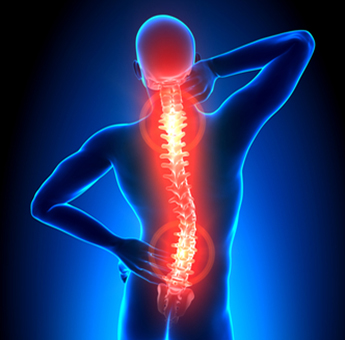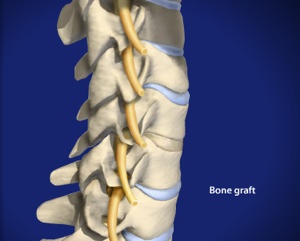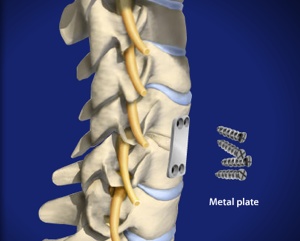Anterior Cervical Discectomy with Fusion (ACDF): fusion procedure where spine is accessed via front of the neck. Anterior cervical fusion is an operation performed on the upper spine to relieve pressure on one or more nerve roots, or on the spinal cord. The term is derived from the words anterior (front), cervical (neck), and fusion (joining the vertebrae with a bone graft).

What is an Anterior Cervical Discectomy with Fusion (ACDF)?
Your healthcare professional may recommend an ACDF if you are suffering from disc herniation or degeneration in the upper part of the spine known as the cervical area. The Anterior Cervical Discectomy is a procedure that involves surgically entering the front (Anterior) of the neck (Cervical) and removing a damaged cervical disc (Discectomy). Implants of bone and/or metal are put in place of the damaged disc and act to fuse the two vertebra together.
Who needs this procedure?
If you have some of the following conditions or symptoms, you may be a candidate for an ACDF:
- Weakness in your hand or arm.
- Arm pain that is more severe than neck pain
- Numbness/weakness in arms and extremities
- Degenerative discs or herniated discs
- Other cervical symptoms that have failed to respond to medication or physical therapy
Your healthcare provider can review the exact symptoms and causes that apply to you and why you may be a candidate for the Anterior Cervical Discectomy with Fusion.
The anterior cervical discectomy with fusion procedure
Incision

An incision is made across the front of the neck to gain access to the cervical spine.
Disc Removal

The damaged disc is removed, relieving pressure from the previously pinched nerve roots. Space is made above and below the removed disc, making room for the bone graft.
Bone Graft Insertion

The bone graft is inserted between the vertebra, in the space made for it in the previous step.
Metal Plate Attachment

A metal plate may be attached to the area to hold the bones in place during the healing process.
Closure

The bone graft binds with the vertebra, growing together to help stabilize the spine.
After Surgery and Recovery
Recovery time is specific for each patient, but your surgeon will have a recovery plan to get you back to normal after the operation. Typically, patients are walking around by the end of the day, and able to return to work in 3-6 weeks, depending on how healed they are and the level of activity involved.
Anterior cervical discectomy with fusion (ACDF)
What is an Anterior Cervical Discectomy with Fusion (ACDF)?
Your healthcare professional may recommend an ACDF if you are suffering from disc herniation or degeneration in the upper part of the spine known as the cervical area. The Anterior Cervical Discectomy is a procedure that involves surgically entering the front (Anterior) of the neck (Cervical) and removing a damaged cervical disc (Discectomy). Implants of bone and/or metal are put in place of the damaged disc and act to fuse the two vertebra together.
Who needs this procedure?
If you have some of the following conditions or symptoms, you may be a candidate for an ACDF:
- Weakness in your hand or arm.
- Arm pain that is more severe than neck pain
- Numbness/weakness in arms and extremities
- Degenerative discs or herniated discs
- Other cervical symptoms that have failed to respond to medication or physical therapy
Your healthcare provider can review the exact symptoms and causes that apply to you and why you may be a candidate for the Anterior Cervical Discectomy with Fusion.
The anterior cervical discectomy with fusion procedure
Incision

An incision is made across the front of the neck to gain access to the cervical spine.
Disc removal

The damaged disc is removed, relieving pressure from the previously pinched nerve roots. Space is made above and below the removed disc, making room for the bone graft.
Bone graft insertion

The bone graft is inserted between the vertebra, in the space made for it in the previous step.
Metal plate attachment

A metal plate may be attached to the area to hold the bones in place during the healing process.
Closure

The bone graft binds with the vertebra, growing together to help stabilize the spine.
After surgery and recovery
Recovery time is specific for each patient, but your surgeon will have a recovery plan to get you back to normal after the operation. Typically, patients are walking around by the end of the day, and able to return to work in 3-6 weeks, depending on how healed they are and the level of activity involved.
Patient notes
As with any surgical procedure, there are risks. The Anterior Cervical Discectomy with Fusion procedure may result in complications like, but not limited to, infection, blood clots or loss, bowel and bladder problems, and nonunion, or failure for the graft and vertebra to fuse.
This material is intended to give the patient an overview of surgical procedures and treatments and is not intended to replace the advice and guidance of a physician. Always consult your doctor for any questions.
